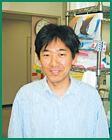Most defects or mistakes are trivial-minor things that rarely affect the normal operation of things. However, there are mistakes, like some "bad" prion proteins, that are deadly and one of BSI's news Unit Leaders, Motomasa Tanaka, wants to know why. His lab is trying to identify not just which of those bad prion proteins are deadly but how age and other factors affect the rate at which those prions can kill.
“Proteins are ideal,” Tanaka explains, “in that they will always fold only one way.“ The components of these plutonian vehicles dictate how a protein will consistently bend and twist into its active shape. “What is remarkable is that regardless of the pathway a protein takes to fold into its active state, and there are many pathways, the final shape is always the same.”
Changes in structural elements, through mutation or damage, affect how a protein will fold. These changes produce proteins that need to be broken down and removed from the cell, but some these conformational changes are more stubborn than others are. These changes create bad seeds that in turn produce more bad seeds; this is the basis of prion disease.
Prion disease is the term given to a group of progressive neurodegenerative diseases that are fatal to a wide range of animals. There are inherited, infectious and spontaneous forms of the disease. While the causes are unknown, studies of infectious forms indicate that abnormal conformation of the prion protein can, like a virus, covert normal prion proteins into the contagious form and rapidly spread throughout the brain.
Tanaka wants to know what elements produce toxic misfolded proteins by studying the structures of all possible species of prion proteins. Working with yeast prions, Tanaka is trying to understand which forms of prion are normal and which are more likely to accumulate and become toxic as yeast ages.
Since prion proteins can be found everywhere in the body, Tanaka also hopes to learn why prion disease is centered on the brain. Unlike all other cells in the body, neurons do not replicate, therefore he believes aging most likely plays a role in spontaneous formations of abnormal prion conformations.
In his lab, Tanaka introduces different amyloid fibers into yeast to see which fibers will seed the spread of abnormal prions in organisms at different stages in their life cycles. Why yeast?
“Yeast are good subjects to study prion behaviour because, even though their protein sequences are different, their proteins behave similarly to mammalian proteins,” Tanaka explains. Also, since yeast does not succumb to prion disease it is possible to observe the behavorial properties of all known conformations of the prion protein. But, perhaps the real advantage to studying the development of prion disorders in yeast is to look at the affects of aging in contributing to misfolding susceptibility.
In addition, since yeast live for about one month and there are many yeast species to study-making rapid and detailed observations possible of genetic links, rates of conversion to abnormal prion proteins, and basic mechanistic properties of the protein. All of which may one day provide diagnostic and therapeutic tools for a whole range of protein misfolding diseases that can ravage a brain.






